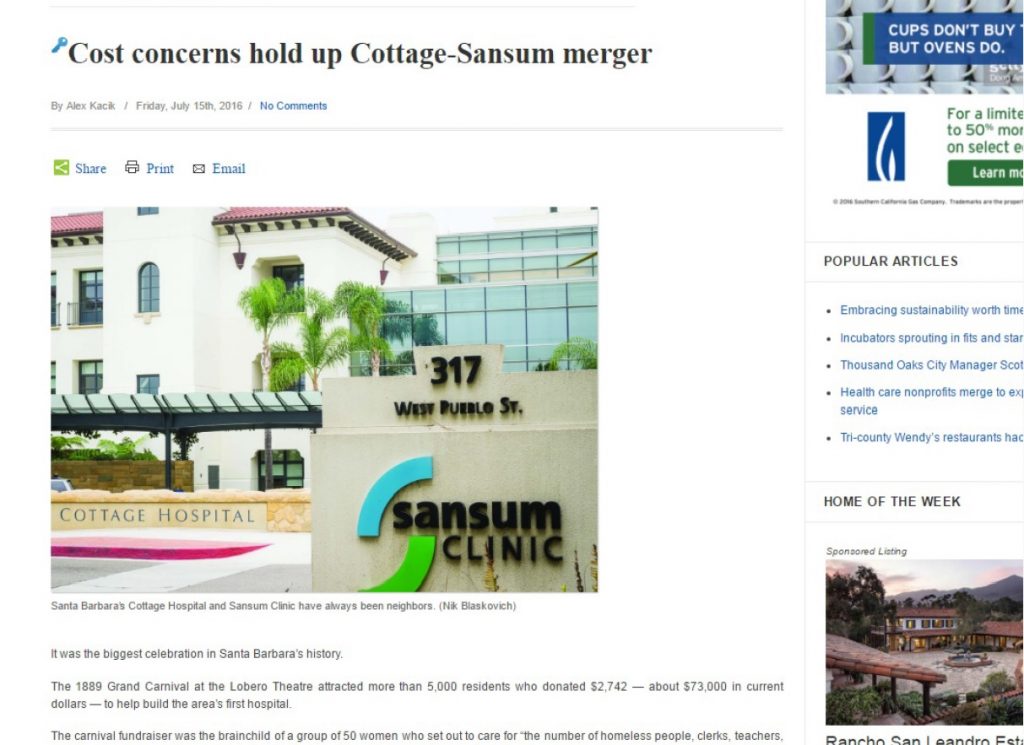Confessions of a Digital Heretic: Nonprofit journalism crashes the paywall

By Henry Dubroff
When Pacific Coast Business Times staff writer Alex Kacik won a USC Annenberg School fellowship in health journalism this year, the last thing on my mind what that his project would run head-on into our paywall.
But that’s precisely what happened after he wrote the first in a series of stories about the proposed merger of Cottage Health and Sansum Clinic, the two dominant health care institutions in the Santa Barbara area. The story, published in print and online in July, broke new ground on the reasons why the Federal Trade Commission has questioned the merger, so we put it behind our paywall to add value for our subscribers.
A few days later, we got an email from Martha Shirk at the Center for Health Journalism at USC. She asked if we would place the story outside our paywall so it could be shared via the center’s newsletter. Alex looked at the fine print in his fellowship agreement. One of the protocols was that we share the URL of our story with the center.
My initial response was “that’s bullshit.” Or perhaps something stronger. However, after stomping around the office, I decided to unlock the story and resist the temptation to share the URL, as required, and leave the story locked down. The Center for Health Journalism clearly intended for its fellowship-supported work to be public and the right thing to do was to respect that intent.
But as the founder and principal owner of the Business Times, I found the Annenberg protocol posed a paywall conundrum.
Pacific Coast Business Times has been successful in part because of its strict adherence to our paywall or what I prefer to call our digital content licensing model. The only way you can get access through our paywall is via a subscription to our print publication — and we’ve been experiencing slow but steady growth in both advertising and subscriptions in the five years since we put that model into place.
Some of our content is print exclusive, some is digital only. We don’t restrict access to breaking news as well as our editorials and commentaries. Our great preference is for in-depth, enterprise and exclusive reporting to be locked behind our pay wall. But it turns out that Pacific Coast Business Times is not alone in facing conflicts over paywalls.
A study published this summer by Mike Annany, coincidentally an assistant professor at USC-Annenberg, concluded that major newspapers temporarily dropped their paywalls dozens of times between 1999 and 2015.
A write up on Annany’s research that appeared in the July 20 newsletter published by Harvard University’s Neiman Lab said paywalls were dropped for a number of reasons, including providing information during natural disasters or coverage for planned events like the World Series as well as for audience development or advertising reasons. As a business journalist, I was fascinated to learn that the Financial Times dropped its paywall on the day after the Brexit vote.
My belief in the paywall is central to the idea that journalists should be paid for their work and my hero in the effort to secure fair pay for a day’s work is recording star Taylor Swift.
This summer, an article in the Wall Street Journal lauded Swift for staring down “tech titans, Chinese e-commerce swindlers” and others by insisting on being paid for her music. Her “To Apple, Love Taylor” letter laid down a big marker for creators of intellectual property and got Apple Music to back down.
Most of us don’t have Taylor Swift’s ability to move markets. But I’d suggest to the folks at Annenberg, Pro-Publica and other nonprofits that support nonprofit journalism that it is worth rethinking whether grant or fellowship-supported journalism has to be free for all.
Some additional thoughts:
- In the book world, it’s perfectly normal for authors and scholars to get grants for their work and then publish books that have to be bought. Why can’t the same model apply to journalists who work for publications that are paid and not free.
- Perhaps if nonprofits are going to support publications that are subscription-based, a small amount of grant money can be set aside to purchase reprints in pdf form that can reside on the grantor’s web site with a link to the paid site. At our company, reprints cost $169.
The bottom line is that both paywalls and nonprofit grants and fellowships are important in the transition to a digital-dominant world. They should complement each other and not be a source of conflict.
• Henry Dubroff is the editor and chairman of the Pacific Coast Business Times.










